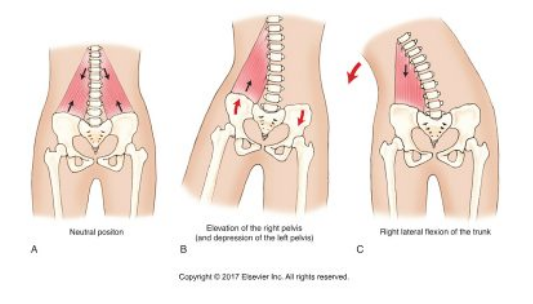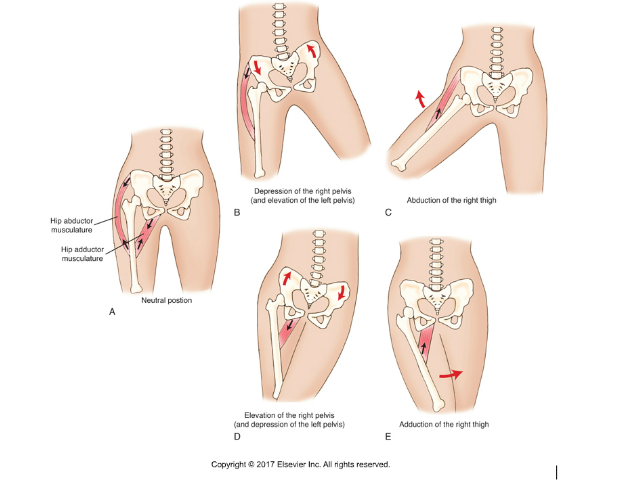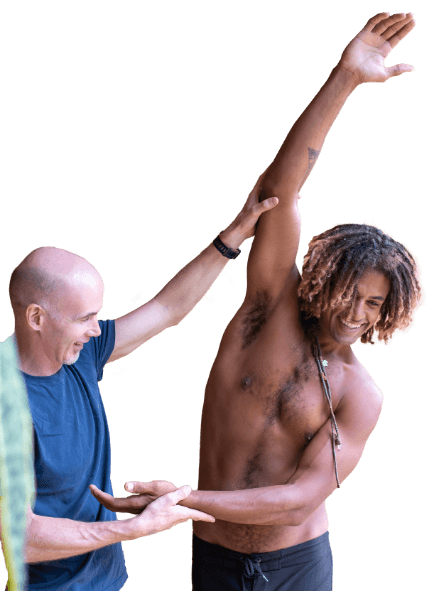
When treating Scoliosis, we need to understand the mechanism that creates the problem. Even though scoliosis can be classified as ‘Idiopathic’, meaning the cause is unknown
(“idio” as in the word “idiot” refers to not knowing; “pathic” refers to the pathologic condition) we can assume there are some muscular and neural imbalances at play. For example, a tight quadratus lumborum (QL) can cause a scoliosis of the lumbar spine; the concavity of the scoliotic curve present on the side of the tight QL.
That’s why we certainly should work in the region of the scoliosis because the scoliosis itself is a postural distortion pattern that creates bony and soft tissue stress factors.
The musculature in the concavity of the scoliotic curve is often locked short and the musculature on the convex side is locked long. Further, the concave side to which the spine is laterally flexing has compression forces on the joints and tension pulling forces occur on the convex side. For these reasons, some practitioners like to use manual therapy which when directed to the soft tissues affected by the scoliotic curve can be effective.

However, if the root cause of the scoliosis is not determined and addressed, then long term improvement is not possible. Therefore, it is necessary for a therapist to determine the mechanism that is causing the scoliosis, or at the very least adding to it.
Other Scoliosis are direct causes of local muscular imbalances. Other scoliosis are also caused by asymmetric postural distortion patterns elsewhere in the body, usually in the lower extremity.
Any pathomechanics that results in an unlevel posture of the pelvis in the frontal (coronal) plane can result in a scoliosis as a compensation. If the pelvis drops in the frontal plane on one side, then if the spine were straight, it would lean over to that side, like the Leaning Tower of Pisa. This would result in the head being unlevel. An unlevel head results in the eyes and inner ears being unlevel, which makes it very hard for the nervous system to determine our posture in space, in other words, proprioception becomes compromised.
The next logical question is what can drop/depress the pelvis in the frontal plane? One possibility is a dropped arch, which lowers the pelvis on that side. Another possibility is genu valgus, a postural distortion pattern at the knee joint in which the (lower) leg, i.e., the tibia is abducted. One more possibility is an asymmetrical pull of musculature across the hip joint in the frontal plane.
Hip Joint Muscles and Scoliosis
There are two groups of musculature that cross the hip joint and attach to the pelvis in the frontal plane. They are the abductors and the adductors.
The abductor group is composed of the gluteus medius, gluteus minimus, upper 1/3 of the gluteus maximus, tensor fasciae latae (TFL), and the sartorius.
The adductor group is composed of the adductor longus, adductor brevis, adductor magnus, gracilis (sometimes known as the adductor gracilis), and the pectineus.
If an asymmetry of baseline tone of these two groups relative to each other occurs, the frontal plane posture of the pelvis can be changed. To better understand this, we need to understand what are known as “closed-chain” or “reverse” actions of muscles. These are actions in which the muscle moves the proximal attachment, the attachment that is often described as the “origin.” At the hip joint in the frontal plane, all muscles that abduct the thigh at the hip joint also do depression of the (same-side) pelvis at the hip joint when the foot is on the ground (closed chain). And all muscles that adduct the thigh at the hip joint also do elevation of the pelvis (of the same-side pelvis) at the hip joint. And of course, whenever the pelvis is depressed on one side, it elevates on the other side, and vice versa.
So, if the abductor group on one side is tighter at baseline tone than the adductor group on that side, the pelvis will be pulled into depression on that side. This would result in a lumbar scoliosis that is convex on that side. If instead, the adductor group on one side is tighter at baseline tone than the abductor group on that side, the pelvis will be pulled up into elevation on that side, which would result in a lumbar scoliosis that is concave on that side.

Keep in mind that this should not be interpreted to mean that a scoliosis is always caused by muscular imbalances across the hip joint. However, it is one possible cause therefore to be assessed. For this reason, when someone presents with a lumbar scoliosis, one of the assessment steps should always be to assess the closed chain mechanics of the hip joint musculature.
For example, if a person has a right lumbar scoliosis (convexity to the right; a scoliosis is always named for the side of convexity), I would evaluate if the abductor musculature on that side and/or the adductor musculature with a series of movements tests. ). If either of these two groups are restricting movement, then they should be treated to see if this helps improve the scoliotic curve. Of course, it is also possible that these muscle groups might be tighter, not because they were primarily, causing the scoliosis; but rather because they adaptively tightened as a result of the scoliosis. In other words, the scoliosis was there first and the right hip joint musculature is secondary.
The bigger picture here is that effective treatment of any musculoskeletal (neuro-myo-fascio-skeletal) condition requires treating the cause of the problem. This requires a thorough physical assessment of all the possible causes. In the case of Scoliosis, one possible cause is tight musculature of the hip joint in the frontal plane.

Over the last 10 years Ed has been building a YouTube library to help people manage their own pain or movement limitations and increase performance through exercise. He regularly adds videos so be sure to subscribe and visit regularly


"Oh My Gosh- I am ALREADY feeling relief after a few days! I used to wake up 2-3 times a night with shooting pain that anti inflammatories couldn't touch. Now I have been waking up just because I want to notice what it feels like to lay in bed pain free- THANK YOU!."

"When I first started with your program I was experience a lot of pain. Walking was difficult. I had to stop and catch my breath every few minutes and lean against a wall for support. Now when I walk with my husband we go for over an hour. I never had to sit down and stop...and, hardly any pain!!! 😊😊 I can’t thank you enough."
Frustrated that you aren't recovering fast enough?
Discover how to heal from illness and injury using movement, food and lifestyle.
Leave a Reply